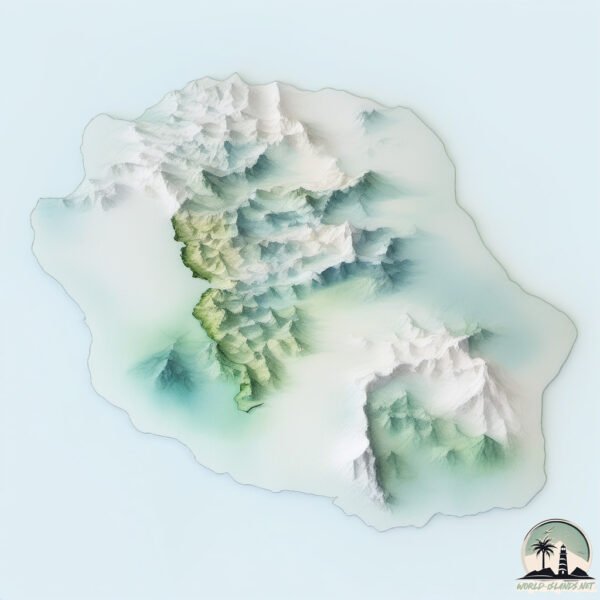Welcome to Reunion , a Temperate island in the Indian Ocean, part of the majestic Indian Ocean. This guide offers a comprehensive overview of what makes Reunion unique – from its geography and climate to its population, infrastructure, and beyond. Dive into the details:
Geography and size of Reunion
Size: 2520 km²Coastline: 234 kmOcean: Indian OceanSea: Indian OceanContinent: Seven seas (open ocean)
Reunion is a Very Large Island spanning 2520 km² with a coastline of 234 km.
Archipel: Mascarene Islands – Located in the Indian Ocean, these islands, including Mauritius and Réunion, are known for their unique wildlife and vibrant cultures.
Tectonic Plate: Somalia – A large tectonic plate covering the Horn of Africa and parts of the Indian Ocean, known for the East African Rift where it’s splitting away from the African Plate.
The geographic heart of the island is pinpointed at these coordinates:
Climate and weather of Reunion
Climate Zone: TemperateClimate Details: Temperate Oceanic ClimateTemperature: Warm Summer
Climate Characteristics: Known for its moderate year-round temperatures with ample rainfall and no dry season. Warm summers are characteristic.
Topography and nature of Reunion
Timezone: UTC+04:00Timezone places: Asia/DubaiMax. Elevation: 3069 m Piton des NeigesMean Elevation: 882 mVegetation: Evergreen Broadleaf ForestTree Coverage: 50%
The mean elevation is 882 m. Dominating the island’s landscape, the majestic “Piton des Neiges” rises as the highest peak, soaring to impressive heights. The island is characterized by Mountains: High, steeply elevated landforms. Characterized by both a high maximum elevation (over 500 meters) and a high mean elevation, creating rugged, mountainous terrains on islands.
Dominating Vegetation: Evergreen Broadleaf Forest
Vegetation: 13 vegetation zones – Exceptionally Diverse Island
Infrastructure and Travelling to Reunion
Does the island have a public airport? yes .
Does the island have a major port? yes .
The mean population of Reunion is 382 per km². Reunion is Moderately Inhabited. The island belongs to France .
The name of the island resonates across different cultures and languages. Here is how it is known around the world: Arabic: لا ريونيون; German: Réunion; Spanish: Reunión; French: Île de la Réunion; Portuguese: Reunião; Russian: Реюньон; Chinese: 留尼汪
Continuing your journey, Mauritius is the next notable island, situated merely km away.
REUNION ISLAND: Ultimate Travel Guide to VOLCANOES & BEACHES in the Indian Ocean
This is the French paradise in Africa! Far away in the Indian Ocean is an incredible nature paradise island called La Réunion.
REUNION ISLAND: Ultimate Travel Guide to VOLCANOES & BEACHES in the Indian Ocean
This is the French paradise in Africa! Far away in the Indian Ocean is ...
This is the French paradise in Africa! Far away in the Indian Ocean is an incredible nature paradise island called La Réunion.
Is It SAFE To Go Back To REUNION ISLAND? Shark Scientist Opinion.
Join shark scientist Kristian Parton as we look into the mystery ...
Join shark scientist Kristian Parton as we look into the mystery surrounding the shark attacks on reunion island. Why were there so ...
Reunion Island Travel Guide: 15 BEST Things To Do In Réunion Island
This Trondheim travel guide shares the best things to do in Trondheim. ...
This Trondheim travel guide shares the best things to do in Trondheim. -------------- How to travel more and visit your dream ...
France is classified as Developed region: G7: Group of Seven – Major advanced economies, including Canada, France, Germany, Italy, Japan, the United Kingdom, and the United States. The level of income is High income: OECD.
News – Latest Updates and Headlines from Reunion
Stay informed with the most recent news and important headlines from Reunion. Here’s a roundup of the latest developments.
Loading...
Social Media Posts about Reunion
Loading...
Please note: The data used here has been primarily extracted from satellite readings. Deviations from exact values may occur, particularly regarding the height of elevations and population density. Land area and coastline measurements refer to average values at mean high tide.

